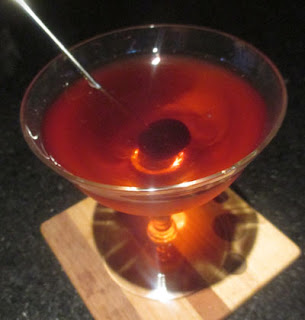1 oz Aged Antigua Rum (R.L. Seale 10 Year Barbados)
3/4 oz Aged Jamaican Rum (Smith & Cross)
1/2 oz 151 Proof Demerara Rum (Lemon Hart)
1/2 oz Don's Spices #2 (1/4 oz Hamilton's Allspice Dram + 1/4 oz Vanilla Syrup)
1/2 oz Orgeat
1/2 oz Passion Fruit Syrup
3/4 oz Lime Juice
1 1/2 oz Pineapple Juice
5 dash Absinthe (2/3 bsp Butterfly)
Whip shake, pour into a Tiki mug, and top with crushed ice. Garnish with Angostura Bitters, pineapple fronds, flower, and clove-studded orange wheel (Angostura Bitters + mint sprigs).
Two Saturdays ago, I was intrigued by another one of Brian Maxwell's drinks of the day on his
Shaker of Spirits blog; his 61st daily post during quarantine was the Ground Control to Major Donn which paid tribute to both Tiki legend Don the Beachcomber as well as musician David Bowie. Brian reminded me that Donn Beach was indeed a major in the Air Force during World War II, and this inspired Donn to name drinks like the
Test Pilot and Q.B. Cooler. Without the Don's Spices #2 and the pineapple juice, the combination reminded me of the
Manuia, so it definitely spoke to me on many angles.

The Ground Control to Major Donn began with a clove, allspice, and mint aroma. Next, lime and passion fruit notes on the sip launched into rum, pineapple, vanilla-earthy, allspice, and anise flavors on the swallow.

































 The 2017 collection of 855 drink recipes, bartender tributes, and essays on hospitality from CocktailVirgin's Frederic Yarm. Available at Barnes and Noble and Amazon.
The 2017 collection of 855 drink recipes, bartender tributes, and essays on hospitality from CocktailVirgin's Frederic Yarm. Available at Barnes and Noble and Amazon. The 2012 collection of 505 drink recipes, techniques, and Boston bar recommendations from Frederic Yarm. Available at Amazon and Barnes and Noble.
The 2012 collection of 505 drink recipes, techniques, and Boston bar recommendations from Frederic Yarm. Available at Amazon and Barnes and Noble.